Grade 9 Exam > Grade 9 Notes > Biology for Grade 9 > NCERT Summary: Tissues
Tissues Summary Class 9 Science Chapter 6
Introduction
- A group of cells that are similar in structure and/or work together to achieve a particular function forms a tissue.
- Most of the tissues in plants are supportive, which provides them with structural strength.
- These tissues are dead, since dead cells can provide mechanical strength as easily as live ones, and need less maintenance.
- Plant Tissues are of two types Meristematic & Permanent tissues.
Meristematic Tissue
- These are simple living tissues having thin walled compactly arranged immature cells which are capable of division and formation of new cells.
Features of Meristematic Tissues:
- Thin primary cell wall (cellulosic).
- Intercellular spaces are absent (compact tissue).
- Generally vacuoles are absent, dense cytoplasm & prominent nuclei are present.
- Large numbers of cell organelles are present.
- Active metabolic state, stored food is absent.
- Actively dividing cells are present in growing regions of plants, example: root & shoot tips.
Classification of Meristematic Tissues on the Basis of Origin
- Primary (Promeristem)
- Derived directly from the meristems of embryo.
- They consist of cells derived from primary meristem.
- They add to primary growth of plants.
- Secondary Meristematic Tissues
- Formed by permanent tissues.
- These are having cells derived from primary permanent tissue.
- They usually add to the diameter of plants.

Classification of Meristematic Tissues on the Basis of Location
- Apical Meristem
- It is present at the growing tips of stems and roots.
- Cell division in this tissue leads to the elongation of stem & root, thus it is involved in primary growth of the plant.
- Intercalary Meristem
- It is present behind the apex.
- It is the part of apical meristem which is left behind during growth period.
- These are present at the base of leaf & internode region.
- These lead to the increase in the length of leaf (Primary), example: in grass stem, bamboo stem, mint stem etc.
- Lateral Meristem
- It is also called as secondary meristem.
- It occurs along the sides of longitudinal axis of the plant.
- It gives rise to the vascular tissues.
- Causes growth in girth of stem & root.
- They are responsible for secondary growth.
Permanent Tissue
- The permanent tissues are composed of those cells which have lost their capability to divide.
- They have definite shape, size and thickness. The permanent tissue may be dead or living.
- The division & differentiation of the cells of meristematic tissues give rise to permanent tissues.
- In cell differentiation, developing tissue and organs change from simple to more complex forms to become specialized for specific functions.
- The cells of permanent tissue loose the capacity to divide and attain a permanent shape, size and function.
- Permanent tissues are classified into two types on the basis of Structure and Composition i.e. Simple Permanent Tissues and Complex Permanent Tissues.
Simple Permanent Tissues
- These are made up of same type of cells which are similar structurally and functionally.
- They include two types of tissue Protective tissues and Supporting Tissues.
- Protective Tissues: These tissues are primarily protective in function.
- They consist of Epidermis and Cork/Phellem.
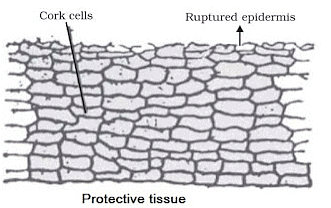
- They consist of Epidermis and Cork/Phellem.
1. Epidermis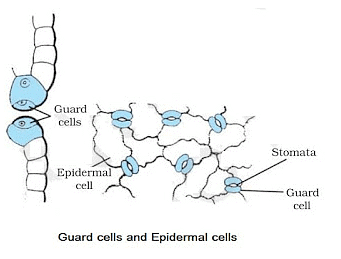
- Epidermis forms one cell thick outermost layer of various body organs of plants such as leaves, flowers, stems and roots.
- Epidermis is covered outside by cuticle. Cuticle is a water-proof layer of waxy substance called as cutin which is secreted by the epidermal cells.
- Cuticle is very thick in xerophytes.
- Cells of epidermis of leaves are not continuous at some places due to the presence of small pores called as stomata.
- Each stomata is guarded by a pair of bean-shaped cells called as guard cells. These are the only epidermal cells which possess chloroplasts, the rest being colourless.
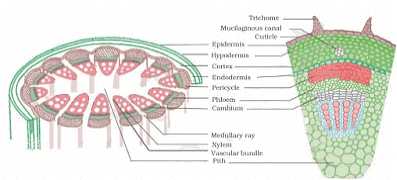
Functions of Epidermis
- The main function of epidermis is to protect the plant from desiccation and infection.
- Cuticle of epidermis cuts the rate of transpiration and evaporation of water and prevents wilting.
- Stomata in epidermis allow gaseous exchange to occur during photosynthesis respiration.
- Stomata also helps in transpiration.
2. Cork or Phellem
- In older roots and stems, tissues at the periphery become cork cells or phellem cells.
- Cork is made up to dead cells with thick walls and do not have any intercellular spaces.
- The cell walls in cork deposit waxy substance called as suberin.
- The cells of cork become impermeable to water and gases due to the deposition of suberin.
- The cork cells are without any protoplasm but are filled with resins or tannins.
Functions of Cork
- Cork is protective in function. Cork cells prevent desiccation, infection and mechanical injury.
- Imperviousness, lightness, toughness, compressibility and elasticity make the cork commercially valuable.
- Cork is used for insulation, as shock absorber in linoleum.
- Cork is used in the making of a variety of sport goods such as cricket balls, table tennis, shuttle cocks, wooden paddles etc.
- Supporting Tissues: These are supportive in function.
- There are three types of Supporting tissues i.e. Parenchyma, Collenchyma and Sclerenchyma.
1. Parenchyma
- It is the fundamental tissue.
- Tissue first time evolved in bryophyte.
- Thin walled cells, oval or spherical in structure.
- Cell wall mainly composed of cellulose & pectin.
- Large central vacuole for food & water storage.
- Primary function is food storage.
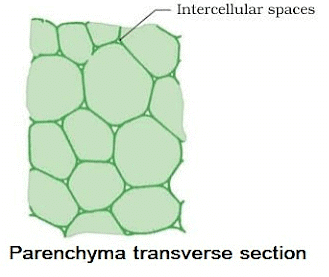
- Some parenchyma involved in excretory substance storage are so called as idioblast, storing such as resin, tannin, gums & oils.
- In typical parenchyma chlorophyll is absent.
- Chloroplast containing parenchyma tissue are chlorenchyma which perform photosynthesis such as mesophyll of leaves.
- In hydrophytic plants aerenchyma (a type of parenchyma containing air spaces) provides buoyancy.
- Parenchyma provides turgidity to cells.
2. Collenchyma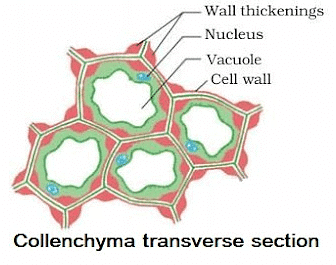
- It is the living mechanical tissue.
- Elongated cells with thick corners.
- Localized cellulose & pectin thickening.
- Provides flexibility to plant parts & easy bending of various parts of plant.
- Present only in herbaceous dicot stem.
- Present at thin margin of leaves.
- Few chloroplasts may be present.
- Gives mechanical strength & elasticity to the growing stems.
3. Sclerenchyma (Scleras–hard) Strengthening tissue.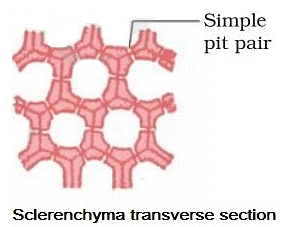
- Composed of extremely thick walled cells with little or no protoplasm.
- Cells are dead & possess very thick lignified walls.
- Lignin is water-proof material.
- Intercellular spaces are absent.
- Cells of sclerenchyma are of two types Sclereids and Fibres.

- Cells of sclerenchyma are of two types Sclereids and Fibres.
Sclereids
- These are also called grit cells or stone cells.
- These are small cells, where lumen is so small due to higher thickening of cell wall, as present in drup fruit (mango, coconut, walnut) in legume seeds (Macrosclereid).
Fibers
- They are very long, narrow, thick, lignified cells. Lumen is large as compared to sclereids.
- They are generally 1-3 mm long.
- In the thick walls of both the fibres and sclereids are present thin areas called as pits.
- Sclrenchyma Fibres are used in the manufacture of ropes, mats & certain textile fibres.
- Jute and coir are obtained from the thick bundle of fibres.
Difference between Parenchyma, Collenchyma and Sclerenchyma
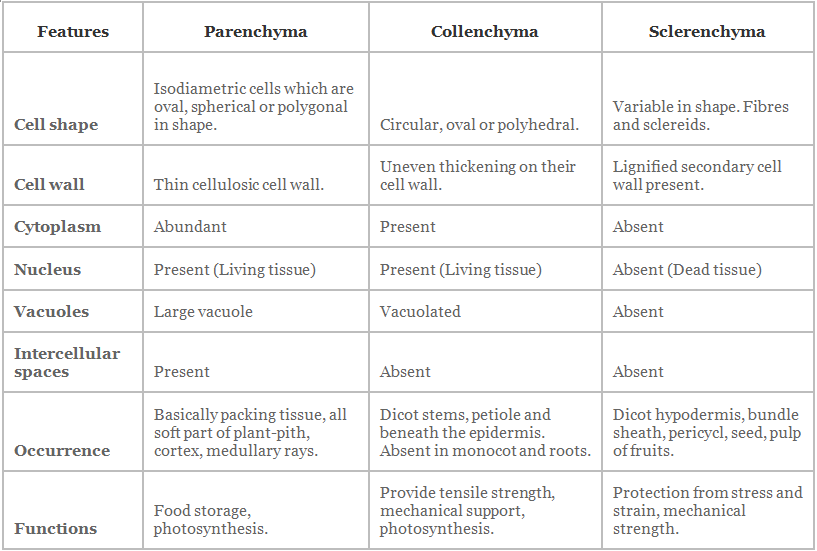
Complex Permanent Tissues
- It consists of more than one type of cells which work together as a unit.
- It helps in transportation of organic materials, water & minerals.
- It is also known as conducting or vascular tissue.
- Xylem & phloem together form vascular bundles.
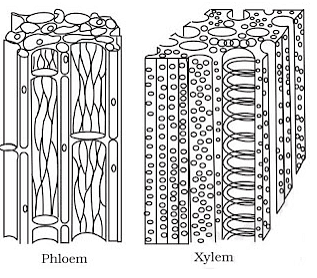
Xylem
- It is also known as wood and is a vascular and mechanical tissue.
- Thick walled cells are found in the form of tubular passages.
- Xylem consists of four types of cells called as elements Tracheids, Vessels, xylem parenchyma and xylem sclerenchyma.
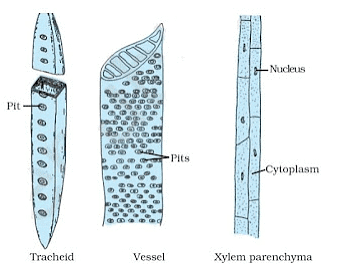
Tracheids
- They are elongated angular dead cells (primitive elements) mainly involved in conduction of water and minerals in gymnosperms.
Vessles
- They are advance element (generally found in angiosperms).
- Vessels are cylindrical tube like structures placed one above the other end to end which form a continuous channel for efficient conduction of water.
Xylem parenchyma
- They are small & thick walled parenchymatous cells subjected for storage of starch (food).
Xylem sclerenchyma
- Thy are non-living fibres with thick walls and narrow cavities provide mechanical support.
- Except xylem parenchyma all other xylem elements are dead.
- The annual rings present in the trunk of a tree are xylem rings.
- By counting the number of annual rings, we can determine the age of a tree.
Phloem
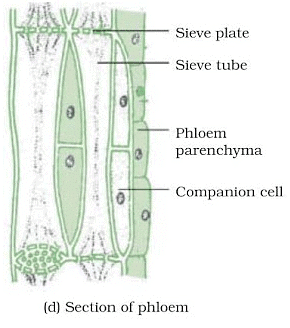
- They also consist of both parenchymatous and schlerenchymatous cells.
- Phloem consists of four types of element which are Sieve tubes, Companion cells, Phloem fibre and Phloem parenchyma.
Sieve tubes
- Sieve tubes are slender tube like structures made up of elongated, thin walled cells placed end to end.
- The end walls of sieve tube cells are perforated by numerous pores, called as sieve plates.
- Nucleus of sieve cell degenerates at maturity. However, cytoplasm persists, because of protoplasmic continuation of sieve tube with companion cell through plasmodesmata.
- Sieve cells possess slime protein or protein which is concerned with growth and repair of sieve cells.
Companion cells
- Companion cells have dense cytoplasm and prominent nuclei.
- Sieve cells & companion cells are so called sister cells because they originate from single mother cell.
Phloem fibre
- They give mechanical support to sieve tubes.
Phloem parenchyma
- They store food and help in radial conduction of food.
Leptome
- Main part of phloem involved in conduction of food, which is sieve tube.
- In xylem, only unidirectional movement is possible while in phloem bidirectional movement can occur.
- In phloem, except phloem sclerenchyma all elements are living.
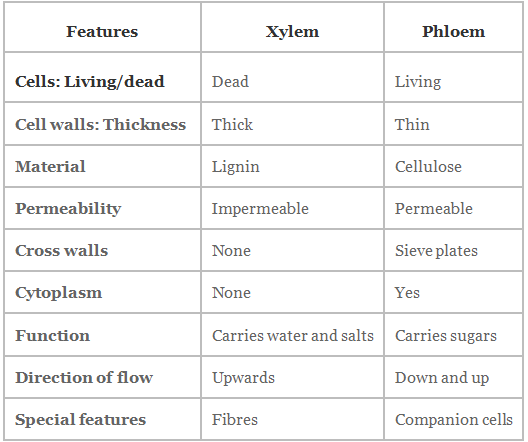
The document Tissues Summary Class 9 Science Chapter 6 is a part of the Grade 9 Course Biology for Grade 9.
All you need of Grade 9 at this link: Grade 9
|
28 videos|68 docs|33 tests
|
FAQs on Tissues Summary Class 9 Science Chapter 6
| 1. What are tissues? |  |
Ans. Tissues are groups of similar cells that work together to perform a specific function in an organism. They can be found in plants as well as animals and are classified into four types - epithelial, connective, muscular, and nervous tissues.
| 2. What is the function of epithelial tissue? |  |
Ans. Epithelial tissue covers the surfaces of the body, both external and internal. Its main function is protection, as it acts as a barrier against pathogens, chemicals, and mechanical abrasion. Epithelial tissue also helps in absorption, secretion, and sensory reception.
| 3. How is connective tissue different from other types of tissues? |  |
Ans. Connective tissue is characterized by having cells scattered in an extracellular matrix. Unlike epithelial tissue, which covers and lines body surfaces, connective tissue supports and connects different body parts. It provides structural support, transports nutrients, and plays a role in defense and repair.
| 4. What are the types of muscular tissue? |  |
Ans. Muscular tissue is divided into three types - skeletal, smooth, and cardiac. Skeletal muscle tissue is attached to bones and enables voluntary movements. Smooth muscle tissue is found in the walls of organs and performs involuntary movements. Cardiac muscle tissue is exclusive to the heart and allows it to contract and pump blood.
| 5. How does nervous tissue function in the body? |  |
Ans. Nervous tissue is responsible for coordinating and controlling body activities. It consists of neurons that transmit electrical impulses and support cells called neuroglia. Nervous tissue enables communication between different parts of the body, processes information, and regulates bodily functions such as movement, sensation, and cognition.
Related Searches
















